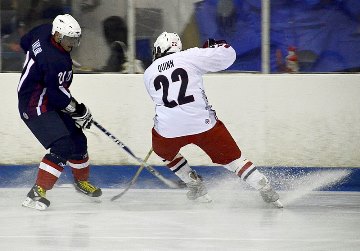Hockey Play Hockey Rules Hockey Strategy Hockey Glossary
Back to the main Hockey page
The Hockey Game
The object of hockey is to have the most goals at the end of the final time period. There are three time periods in hockey. If the game is tied at the end of the three periods, the tie may be broken in overtime or in a shootout.

The Hockey Rink
The hockey rink is 200 feet long and 85 feet wide. It has rounded corners to allow the puck to keep moving even through the corners. There is a goal at each end of the rink with room (13 feet) behind the goal for hockey players to skate around it. There is a red line dividing the center of the hockey rink. There are two blue lines on each side of the red lines that divide the rink into three zones:
1) The Defending Zone - the area behind the blue line
2) The Attack Zone -the area behind the other teams blue line
3) The Neutral Zone - the area between the blue lines
There are also five face-off areas. There is one face-off circle at the center of the hockey rink and two at each end.
Ice Hockey Players
Each hockey team has 6 players on the rink at a time: the goaltender, two defensemen, and three forwards (left, right, and center). Although the defensemen are primarily defenders and the forwards are primarily goal scorers, all the hockey players are responsible for whatever action is happening on the rink. The hockey puck moves fast and so do the players. Defensemen will often be involved in the offense and forwards are responsible for defending their area of the hockey rink.
The forwards and defensemen often play as units called lines. The forward lines change often to give these hockey players rest during the game. Defense lines change as well, but not as often. The goalie usually plays the whole game unless he begins to struggle. Then the goalie may be replaced for another goalie.